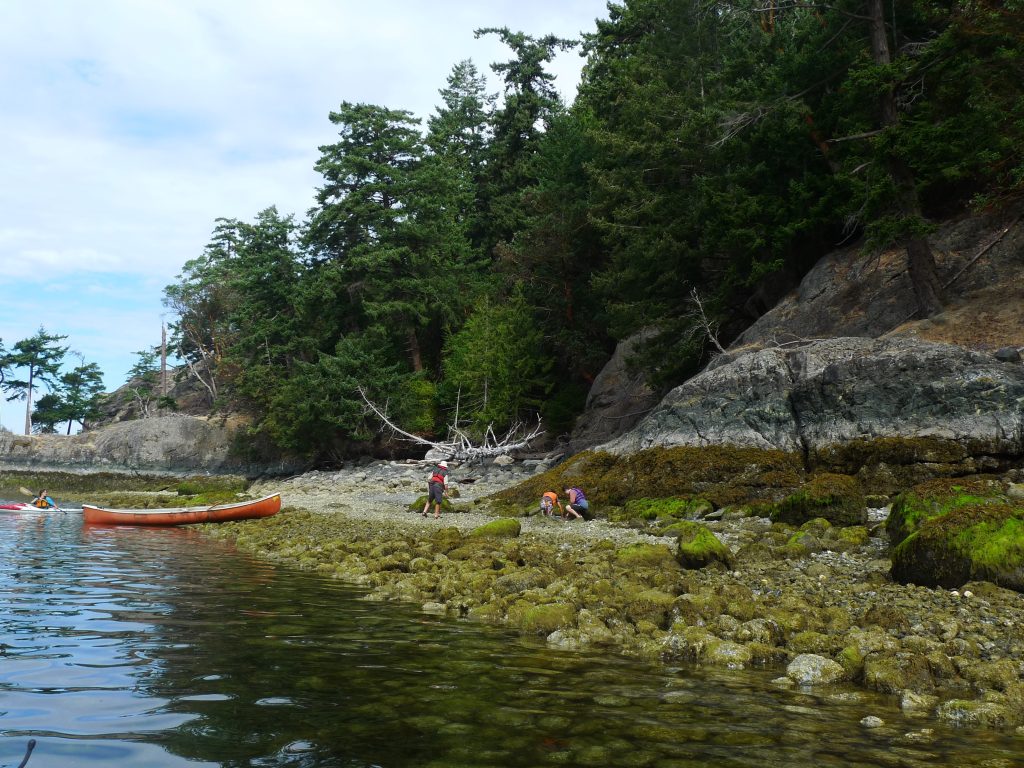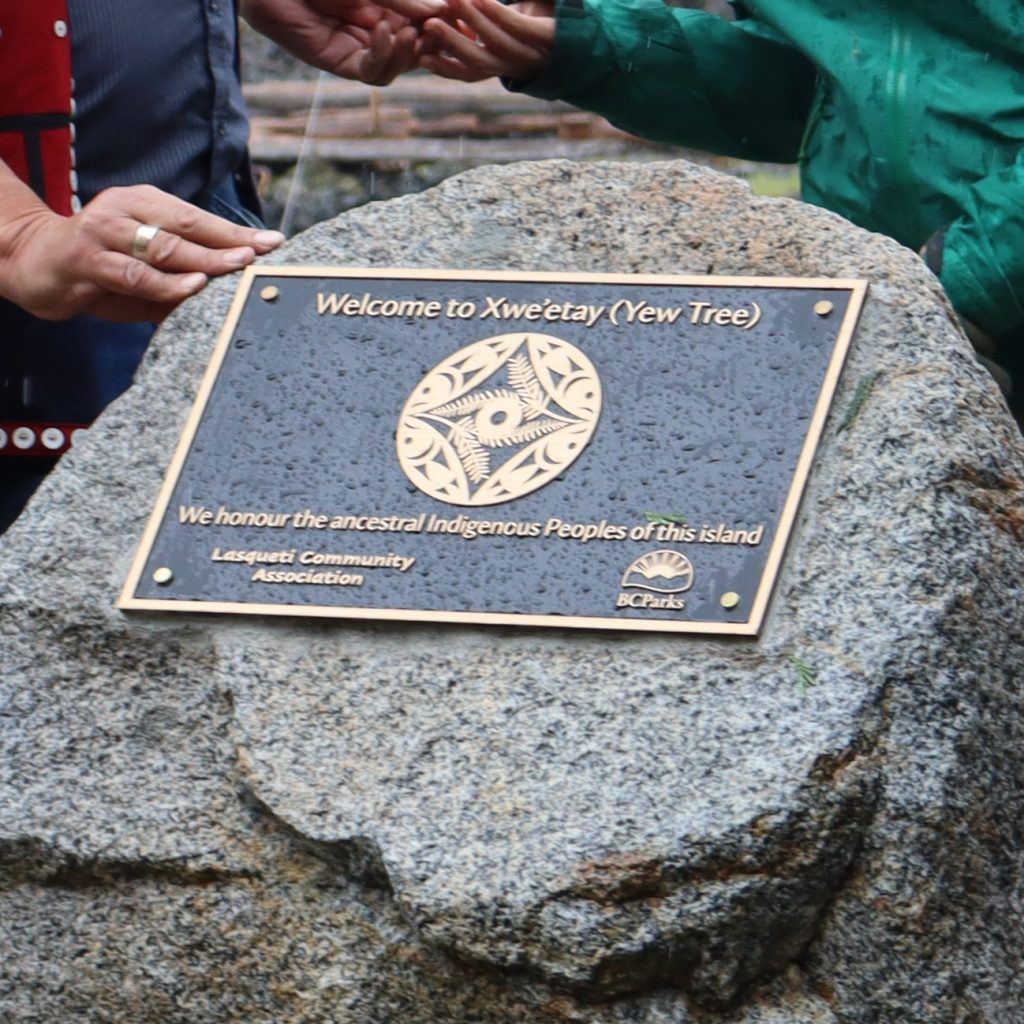Community-led reconciliation in action at Squitty Bay Park
Categories:
“It was the beginning of a relationship, and the beginning of this nebulous thing called reconciliation. People brought beautiful food, and it was a spectacular gathering. The connections that were made were so deep.”
Last July, a very special event took place at Squitty Bay Park on Lasqueti Island. It was led in part by Dana Lepofsky, a professor in the Department of Archaeology at Simon Fraser University, who has been actively working on the B.C. coast for over 30 years. In her words, she has a “background of working with Nations, doing community work, and spending a lot of time in the dirt.”
Dana helped start Xwe’etay/Lasqueti Archaeology Project a few years ago and helped host a gathering at Squitty Bay to honour Indigenous heritage and connection to land. We sat down with both Dana and Randolph, the Language Coordinator at Tla’amin Nation, who participated in the gathering.
Read on to learn more about this important event, and how one community is taking action towards reconciliation.
What is the Xwe’etay/Lasqueti Archaeology Project? How did it come to be?
Dana: It’s been an idea that’s been brewing for the last 20 years or so… I’ve been on Lasqueti myself for 30 years. When I first got here, I saw a beautiful archaeological record that was being destroyed.
One of the first things I heard from settler locals was that Indigenous people never lived here permanently. About 20 years ago, I started giving public talks on the island and writing articles for the community paper. I wanted to bring archaeology and Indigenous connection to place into the forefront.

About five years ago, a friend and I hosted a beautiful community engaged salvage operation around a previously unreported archaeology site on his property. The community came out in droves. We realized this was the time to launch the Xwe’etay/Lasqueti Archaeology Project.
I wanted to work with all Nations who have ancestral connections to the land, and I also wanted to work with settlers, which many archaeology projects don’t do. I wanted to bring everyone together. And, to make real change, I knew we needed to both work from the ground up and from the top-down. To do the latter, I am so fortunate to have joined forces with Sean Markey, a SFU professor who specializes in community policy and planning. So far, five Nations with cultural connections to the island have joined the project: Qualicum, Tla’amin, K’omoks, Halat, and Wei Wai Kum.
Together with a host of wonderful students and local islanders, we are focusing on three elements in our project:
- Using archaeology as a way to educate and bring people together in conversation – to talk about the cool stuff and the hard stuff.
- Documenting the location, age, and extent of the archaeology and historical changes to the archaeological sites and cultural features (e.g., camas beds, wetlands).
- Translating it all into policy and planning to better protect and honor Indigenous heritage.
Randolph, how did you get connected with Xwe’etay/Lasqueti Archaeology Project?
Randolph: In 2021, I met Dana when she was doing archaeology work on my family’s property in Scuttle Bay. They found 4 posts for a longhouse on the property during that project!
In 2022, she and others reached out to see if some Nation members wanted to participate and witness the plaque event. I went, and it was such a great event.
We’ve heard it was an incredible event at Squitty Bay Park last July. Can you tell us more about it?
Dana: Community members were concerned about a plaque at Squitty Bay Park that honours the Spanish “discovery” of the island. So, we reached out to BC Parks and learned that the plaque itself was not put up by BC Parks, but by some islanders in the past. The current community wanted to also ensure there was a plaque at the park that honours Indigenous people.
We applied for funding through the Park Enhancement Fund to help create the plaque, install it, and hold a community event around it with both Indigenous and non-Indigenous neighbours.

It was beautiful weather in the lead up to the event, and the day of the event was just an awful February-like day in July. But people still came out in droves, and it was perfect in all ways.
I had gotten so caught up in the planning details that I lost sight of the original purpose of this event. And then when people arrived and we unveiled the plaque, the rain stopped – community members from five different Nations came and put their hands on the plaque and I thought “Oh my gosh – this is why we’re here.”
It was the beginning of a relationship, and the beginning of this nebulous thing called reconciliation. People brought beautiful food, and it was a spectacular gathering. The connections that were made were so deep.
Randolph: A group of us came over from Powell River to Lasqueti Island the morning of the event. Dana and others had come to pick us up to drive us to the site. Right away, I could tell that the community really came together to make things happen. Dana opened the event and provided information about why everyone was pulled together for the day. I said some opening comments as well. Afterwards, the community came together to feed us all. They were very courteous about ensuring we ate –- the meal was planned out of the backs of people’s cars and was very simple — it touched my heart. It was a reminder that connection is key, and to slow down, take a deep breath, and just enjoy the moment.

What was your biggest takeaway from this gathering?
Randolph: My biggest takeaway was around togetherness and how well we all worked together. And how awesome the people are there on Lasqueti. They provided mountains of food and giveaways. They are so friendly and built a wonderful community.
Dana: Affirming what we can do when we come together. It’s all about bringing people together. When you stop long enough to reach out, and trust enough to reach out in return – this is what can happen.
Dana, this is such a powerful example of communities coming together. What advice do you have for other communities in B.C. who may want to embark on leading a similar project?
Dana: A lot of communities and organizations are doing work with local First Nations on a shoestring budget. There isn’t a lack of desire, or trust, but it’s funding.
Get some money through grants or other avenues, and if you build it, they will come! Don’t be afraid to knock on doors or make cold calls – make them and then make them again. And always have food. Bottom line. There must be food. ?

A huge thank you to Dana and Randolph for sharing their perspectives about the event and the important work taking place on Xwe’etay / Lasqueti Island.
For more information about the event, visit: https://www.lasquetiarc.ca/plaque-unveiling
To learn more about Xwe’etay/Lasqueti Archaeology Project, visit: https://www.lasquetiarc.ca/




